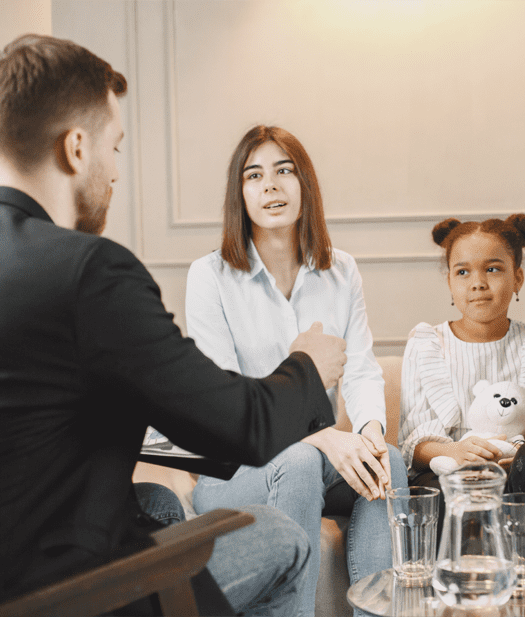Brief Strategic Family Therapy (BSFT®) is an award-winning evidence-based practice that treats externalizing (e.g. substance abuse, acting-out, truancy, bullying) and internalizing (e.g. depression, anxiety) symptomatology in youth aged 6-18 years while restructuring problematic family interactions. The BSFT model is a trauma sensitive, culturally competent, strength-based model.
Within the Title IV-E Prevention Services Clearinghouse, it is one of the few models rated well-supported in all 3 of these categories: mental health, substance abuse and in home parent skills.
The BSFT model uses a structured, problem-focused, directive, and practical approach to the treatment of child/adolescent conduct problems. Common such problems include drug use, associations with antisocial peers, truancy, bullying, and other recognized youth risk factors. It uniquely addresses cognitive, behavioral, and affective aspects of family life. The BSFT model incorporates effective processes of change from other models including strategic and structural approaches, existential/emotive therapy, eco-systemic approaches, and cognitive behavioral approaches.


Through focused interventions and skill building strategies, BSFT® provides families with the tools to overcome individual and family risk factors. The approach is based on the assumption that family-based interactions strongly influence how children behave, and that targeting and improving maladaptive family interactions reduces the likelihood of symptomatic behavior.
The therapist works with the family to identify interactional patterns that give rise to and/or maintain problematic youth behavior. After these patterns are identified, the therapist helps the family change these patterns to encourage positive family interactions.
To restructure interactions and change systems, the BSFT model addresses family behavior, affect, and cognition. The strategies and treatment plans are designed specifically for each family and are based on a structured diagnostic plan. The therapeutic process uses techniques of:
The program fosters parental leadership, appropriate parental involvement, mutual support among parenting figures, family communication, problem solving, clear rules and consequences, nurturing, and shared responsibility for family problems. In addition, because the efficacy of BSFT does depend on family’s abilities to come into the session, BSFT provides specialized engagement strategies for bringing families into therapy.
BSFT is recognized as a “Well Supported” model by the Title IV-E Prevention Services Clearinghouse, “Model” program by the California Evidence Based Clearinghouse, as well by CSAP, and by the OJJDP, among others.
FTTIM highly recommends the purchase of the comprehensive book Brief Strategic Family Therapy. “BSFT builds on the love that is trapped behind the anger, anguish and frustration that permeates clinical families with troubled youth. BSFT transforms family interactions from anger to love, and from conflictive to collaborative.” –Szapocznik and Hervis
The program fosters parental leadership, appropriate parental involvement, mutual support among parenting figures, family communication, problem solving, clear rules and consequences, nurturing, and shared responsibility for family problems. In addition, because the efficacy of BSFT does depend on family’s abilities to come into the session, BSFT provides specialized engagement strategies for bringing families into therapy.
BSFT is recognized as a “Well Supported” model by the Title IV-E Prevention Services Clearinghouse, “Model” program by the California Evidence Based Clearinghouse, as well by CSAP, and by the OJJDP, among others.
FTTIM highly recommends the purchase of the comprehensive book Brief Strategic Family Therapy. “BSFT builds on the love that is trapped behind the anger, anguish and frustration that permeates clinical families with troubled youth. BSFT transforms family interactions from anger to love, and from conflictive to collaborative.” –Szapocznik and Hervis
Brief Strategic Family Therapy® is typically conducted in an average of 12-17 weekly sessions, depending on the severity of the problems. In various studies, the full range has been 8-24 weekly sessions. A typical therapy session lasts 60 to 90 minutes.
The 4 steps of the intervention consist of:

One full-time therapist can provide the BSFT intervention to 15-20 families, if conducted in the office. Or, it can service 10-12 families if conducted at the home, clinic, or other location outside the office. On the average, a BSFT therapist can typically treat 25 – 55 families to completion within one year.
We strongly encourage that the agency create a program structure which includes at least three therapists assigned to conduct the intervention – even if on a part time basis. This will allow therapists to support and consult with each other about BSFT.
BSFT® can be implemented in a variety of settings. They include community social services agencies, mental health clinics, substance abuse prevention and treatment clinics, health agencies, and family clinics. Because BSFT works with the whole family, the program usually operates during afternoons, evenings and Saturdays.
Because collecting outcome measures is important, at FTTIM we recommend the tools described on this FAQ page:
BSFT is notable as a model developed for its cultural competence with language and cultural minority families. While originally developed for Hispanic families, the model has been tested with other populations including African Americans, women, and those with HIV/Aids. An extensive list of adaptations has been made by the co-developer to a variety of settings. These include foster-care, Native American reservations, home-based and community clinic settings, transitional programs and others.
Relative to comparisons, participating children/adolescents and their families showed:
In addition, Families showed significant:
Therapists must be fully trained to competency in Brief Strategic Family Therapy in order to practice this trademarked model. In fact, immediately upon commencing training, the clinicians begin working with families using the model.

These BSFT practitioners must be able to intervene in families to improve maladaptive patterns of interactions. Additionally, they must encourage family members to support and rely on each other, rather than on the therapist. Therefore, therapists must be comfortable making close connections to people at all 3 levels of human experience: cognitive, behavioral and emotional.
Preferably, this ideal candidate has a Master’s degree in mental health, social work, or marriage and family therapy. However, individuals with a Master’s degree in a related field, or a Bachelor’s degree plus 3 years of clinical experience may be qualified. At minimum, individuals must have basic knowledge of how family systems operate.
Organizational considerations include:

Successful organizations aiming to duplicate evidence-based models like BSFT® must have an administrative as well as theoretical commitment to family therapy. To that end, they need to provide the necessary administrative support, and address issues prior to implementation. Following program start-up, they must maintain this commitment via a close relationship to the developers that will secure the maintenance of fidelity over time.

The most recent cost-effectiveness study of BSFT, which was conducted in Maryland, showed that the cost for treating one family through the full range of 24 sessions was only $3,200.
That equates to $133 per session, or in a typical family of 4, $800 per person for the full cost of treatment. In summary, in the study, it cost $33 per person, per session. This is a fraction of the cost of maintaining a youth in residential facilities.
For example, in Kansas, the cost of Youth Residential Centers placements was reported at $45,990 annually per bed, with a majority of youth discharging unsuccessfully, and reporting that long term positive results for youth were not achieved. (2015 Cost Study of Youth Residential Centers for Juvenile Offenders, Kansas Dept. of Corrections.)
Similarly, in 2007 The Department of Juvenile Services (DJS), State of Maryland, reported the annual cost for the placement of one youth in a state-run home to be $52,256.
By employing BSFT® as an alternative to sending a youth to such residential facilities results in a cost avoidance that can then be redirected to further funding the model’s implementation. Thus, more families and at-risk populations can be served.
In general, various studies exist in the United States that show how the successful implementation of evidence based practices reduces crime and saves billions of taxpayers’ money. “Interventions that follow all evidence-based practices can achieve recidivism reductions of 30 percent. In one widely cited 2006 review of more than 550 program evaluations, the Washington State Institute for Public Policy found that a moderate to-aggressive investment in evidence-based programs would save state taxpayers $2 billion, avert prison construction and reduce the crime rate.” Citation: Pew Center on the States, One in 31: The Long Reach of American Corrections (Washington, DC: The Pew Charitable Trusts, March 2009).

Adaptations should only be made in consultation with the model’s developers in order to retain the core components of the model while still preserving its effectiveness. BSFT and its adaptations have been implemented in more than 30 states in the USA, as well as abroad, and in a variety of clinical formats, including home and center-based programs.
The BSFT model was originally developed with Hispanic/Latino families but was subsequently tested with African American families as well. More recently it was selected by NIDA to be the adolescent treatment model to be tested as part of the National Clinical Trials Network. It was tested in 8 sites throughout the country with populations of all ethnic groups. The model is currently utilized in a wide variety of geographical settings. It has proven to be successful with foster—as well as intact—families of varied ethnic backgrounds, and with deaf and/or near deaf families.
It has also been implemented in the service delivery field with several language and cultural minority groups, including Native Americans. BSFT was also successfully tested in the treatment of children ages 6 thru 12 who presented with externalizing and internalizing symptomatology. That study was awarded the Outstanding Research Award by the American Association for Marriage and Family Therapy in 1989.